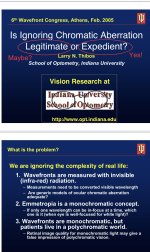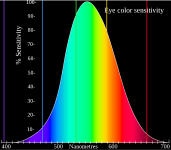elkcub
Silicon Valley, California

The
Could you provide the journal article, or reference to it, for the Indiana U. research study?.
Thanks,
Ed
Note: 572 nm is the peak sensitivity of the L (long wavelength) cone cell, which may account for the Indiana results.
According to THIS Wiki article, "The standard luminous efficiency function is normalized to a peak value of unity at 555 nm," and all texts that I'm familiar with say the same.For those who are interested, Indiana University conducted a research project aimed at isolating just which monochromatic wavelength is used by the himan eye when bringing an object to sharp focus. It turns out to be 572nm, which is somewhat close to the wavelength area representing the eye’s primary photopic response, but still somewhat removed enough for the difference to be significant when determing the dioptric value of ophthalmic lenses. The photopic peak response is said to lie between 555nm and 560nm (560nm is the ISO reference).
B
Could you provide the journal article, or reference to it, for the Indiana U. research study?.
Thanks,
Ed
Note: 572 nm is the peak sensitivity of the L (long wavelength) cone cell, which may account for the Indiana results.
Last edited:






